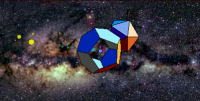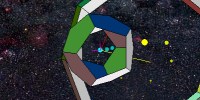

In the interactive model here, the force on the primary orbiter is plotted as a red line, while its velocity is in yellow. The force law used is one-over-radius-squared, so the model simulates both the gravity force between two point masses, and the electrostatic attraction between opposing point charges. Objects shadowing the primary orbiter are three and six iterative time-steps back. Javascript buttons below the window let you choose a few different orbits. The mouse can be used to re-orient the view, and zoom in. Double-clicking on the model stops the simulation, and allows you to "drag" the primary orbiter to other orbits as well.
The Load/Read coordinate buttons and windows above allow more quantitative experimentation, e.g. by letting you type in your own initial position and velocity coordinates.
This page is http://www.umsl.edu/~fraundor/nanowrld/newlive/spinning.html. Acknowledgement is due particularly to Martin Kraus for his robust Live3D applet. The galactic panorama is copyright Axel Mellinger, and is adapted here with permission, from his 300MB All-Sky Milky-Way. Thanks also to former grad student researcher Noom Pongkrapan for the simulator border. Although there are many contributors, the person responsible for errors is P. Fraundorf. This site is hosted by the Department of Physics and Astronomy at UM-StL. MindQuilts site page requests ~2000/day approaching a million per year. Requests for a "stat-counter linked subset of pages" since 4/7/2005: .